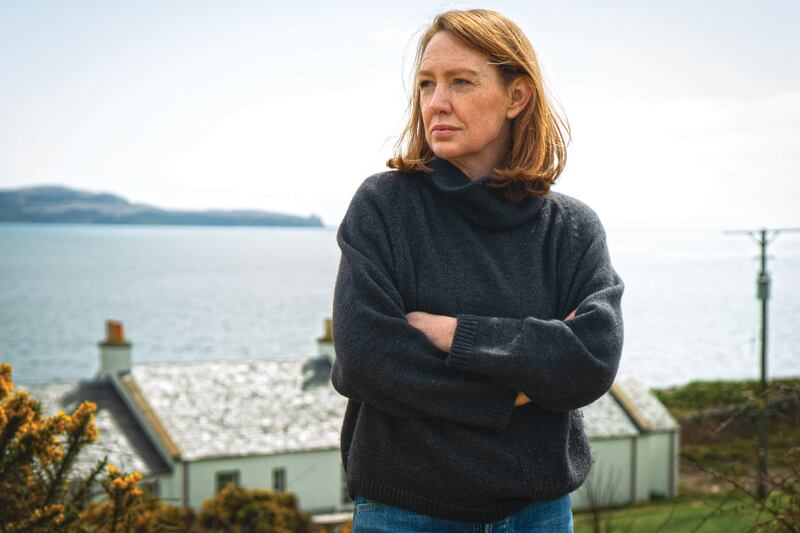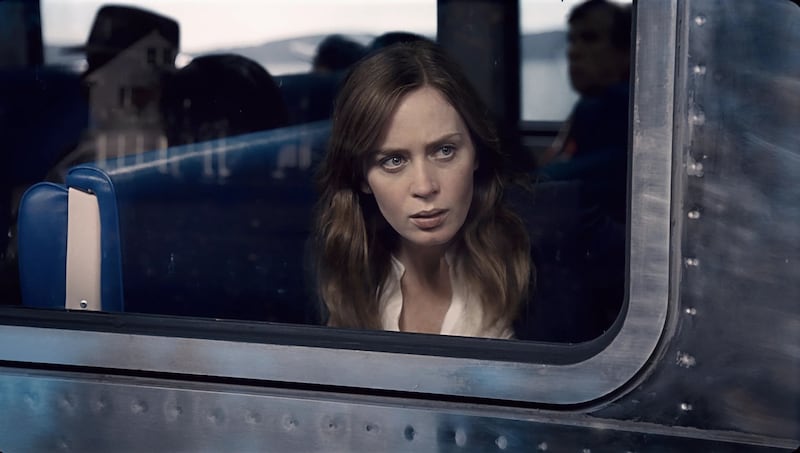It’s raining in both Dublin and London when author Paula Hawkins appears via video, as though the weather is channelling a little of the stormy drama in her latest thriller, The Blue Hour, set in Scotland.
Sitting before packed bookshelves, the author of 23 million-selling The Girl on the Train sips from a large white mug and considers each question. She’s no extrovert and is facing into a long day of press interviews in advance of a UK and US tour, and must pace herself.
“There are so many books at the moment, it’s crazy ... so if any journalists are interested, that’s fantastic,” she says.
[ Girl on The Train’s Paula Hawkins: ‘People think terrible things’Opens in new window ]
To her delight, to promote her latest novel, her publisher projected a giant image of its striking blue and white cover on to the Tate Modern, a fitting canvas for a book involving art and ambition.
READ MORE
“I’m interested in visual artists, and I’m interested in the way they talk about their own work and talk about their lives,” says Hawkins.
Perception fascinates her and she often returns to the topic in her writing: “how we see people and how other people see us, how we judge each other ... And the whole question of legacy seems to be so interesting, when you talk about what we leave behind, how people interpret what we leave behind.”
The setting for the novel struck her while on holiday in Brittany. “I remember walking on the sand when the tide was out, and seeing some of these tidal islands. And there was one that had – it was tiny – and it had one little house on it, all by itself. And I had that feeling then that you sometimes get where you think, Oh, there’s something in that, definitely,” she says.
“Obviously there’s a location that is great for a crime novel, because it’s kind of got locked-room possibilities, and it’s very beautiful and remote. But what I was thinking about was, like, What kind of person would actually want to live in a place like that?”
A visual artist, it turned out.

Meticulous in her research, Hawkins watched creatives at work in their studios, and read memoirs and biographies to help bring to life Vanessa Chapman, the artist whose legacy forms the linchpin of the novel.
“I read a biography of Barbara Hepworth, and she spoke so well about her work and her life and creating things. And I read Celia Paul’s memoir, Self-Portrait, which was incredibly revelatory about what it feels like to paint and to be painted and all those kind of things.”
The experience was “really interesting”, she says, so much so that she had to cut back some of the material she had written for the novel. “Because not everyone’s maybe that into art, but getting the texture of it was really important for me.”
What I’m trying to do most of the time is show people who have the capacity to do bad things and good things
The book is largely set on Eris, a beautiful, rugged and fictional tidal island off the coast of Scotland. Events begin when a small bone at the centre of a famous sculpture is discovered not to have come from a deer, but from a human. James Becker, the curator with responsibility for the piece, sets out to discover the truth about the sculpture as well as secure the remainder of Chapman’s estate, which legally belongs to the museum where he works, but remains on the island with the artist’s executor and friend, Grace Haswell.
Through extracts from Chapman’s diary, correspondence and through the eyes of others, the story unfolds. There are, of course, other mysteries to uncover. There’s a gratifying sense of discovery in the careful tapestry of timelines, and there are echoes of AS Byatt’s Possession, particularly in Haswell’s and Becker’s sense of ownership of Chapman’s legacy.
The artist’s struggle to balance her desire for artistic freedom and her need to belong to the world is vividly portrayed. It’s a natural push and pull for creatives, says Hawkins.
“So many people, creative people, so many artists, have that impulse to run away, get away, often attracted by a particular landscape that is inspiring to them,” she says. “You want to be out there, left to work and to be yourself, but you also need to be plugged into the world and you need people around you.”
There are sacrifices to be made to live a “very untethered, independent life”, she says, and she is tempted by it, but recognises it’s only a fantasy.
“I also know that if it happened, I would probably be lonely and go slightly mad.”
Among Chapman’s correspondence is a letter to another female artist in which Chapman says she’s relieved not to have children.
“It always seemed to me that family is the antithesis of freedom,” she writes, to which her friend replies “you absolutely can be a mother and be free”.
Hawkins agrees.
“I don’t have children, which, frankly, makes everything simpler because you just have more time if you don’t have children,” she says. “But lots of people did. Barbara Hepworth had triplets, and lots of artists have had children. So that whole thing about, ‘Oh, it’s impossible’, is clearly not true.”
The subject turns to other characters in the novel and their complex natures. Becker is a good man, though flawed and blinkered. Even her terribly bad characters have some saving grace.
“What I’m trying to do most of the time is show people who have both, who are complex and who have the capacity to do bad things and good things.” Haswell and Becker are also both outsiders gazing in on others’ lives. Many authors, too, have a sense of outsider-ness. Is it almost a prerequisite for writing?
Hawkins is unsure, though she certainly feels it. “It is true of me that there are times in my life when I felt very outside of things,” she says.
In 1989, while in her mid-teens, she and her family moved to London from Zimbabwe. It was “quite a big wrench” and her “loneliest time”.
“I think a lot of that loneliness did go into the fiction, or the start of it anyway.”
Being an outsider and being an observer go hand in hand, she says. “Because there’s something about sort of slightly sitting things out and watching what other people are up to that lends itself to writing fiction.”
She enjoys writing about people who don’t really fit in. “I think those are the characters where you’re going to find that sort of grit and that scope for conflict, that scope for drama that you really need. I think it’s very difficult to do that if you’re just writing about happy, well-adjusted people.”
After completing politics, philosophy and economics at the University of Oxford, Hawkins worked as a financial journalist and wrote romantic comedy under the pen name Amy Silver.

Her thriller debut, published in 2015, became an instant bestseller and was made into a movie starring Emily Blunt. “It’ll be 10 years in January since The Girl on the Train was published and, yes, it completely changed my life like 90 per cent for the better,” she says.
The financial returns were “very nice” and success opened many doors for her, including into festivals and prize judging. “I like festivals because I actually really love to talk about other people’s books, not just my own. You get sick of talking about your own book.”
[ Girl on the Train author Paula Hawkins makes world's richest writers listOpens in new window ]
It was an exciting time, but also “incredibly fraught”.
“It was quite overwhelming to suddenly have to be the focus of attention quite so much. And that was uncomfortable for me in some ways.”
When her second thriller, Into the Water, appeared in 2017 it sold “pretty well”, but “wasn’t well reviewed”.
“That was obviously quite painful,” she says. “It was very difficult to write that book, because it was, the whole process was so interrupted ... I feel now that maybe I should have taken more time with it.”
She took more time with A Slow Fire Burning, which appeared in 2021, and critics gave it a better reception. And blurbs from authors for The Blue Hour are full of praise. Donal Ryan, whom Hawkins greatly admires, called it “beautifully composed and brilliantly conceived”, while John Boyne described it as a “literary thriller”.
Does the tag “literary” hold much value for her?
“I guess in my own head, I associate literary-ness with good writing. And that’s possibly not actually true, but I think that’s what we do associate it with and that is the sort of space that I would like to go into ... They’re the books I most want to read.”
Thriller writer Kate Atkinson is one of her favourites along with Pat Barker, who writes “pacy books but that are also literary”.
“The ambition, I suppose, is to try and be in that space where you have that really pacy book that people want to, you know, keep going into the night with, but then also find there is more to it, and could return to it.”
The Blue Hour by Paula Hawkins is published by Doubleday





















